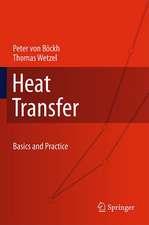The Airborne Microparticle: Its Physics, Chemistry, Optics, and Transport Phenomena
Autor E. James Davis, Gustav Schweigeren Limba Engleză Paperback – 6 noi 2012
Preț: 430.10 lei
Nou
Puncte Express: 645
Preț estimativ în valută:
82.31€ • 89.38$ • 69.14£
82.31€ • 89.38$ • 69.14£
Carte tipărită la comandă
Livrare economică 19-25 aprilie
Preluare comenzi: 021 569.72.76
Specificații
ISBN-13: 9783642628061
ISBN-10: 3642628060
Pagini: 868
Ilustrații: XIV, 834 p.
Dimensiuni: 155 x 235 x 53 mm
Ediția:2002
Editura: Springer Berlin, Heidelberg
Colecția Springer
Locul publicării:Berlin, Heidelberg, Germany
ISBN-10: 3642628060
Pagini: 868
Ilustrații: XIV, 834 p.
Dimensiuni: 155 x 235 x 53 mm
Ediția:2002
Editura: Springer Berlin, Heidelberg
Colecția Springer
Locul publicării:Berlin, Heidelberg, Germany
Public țintă
ResearchCuprins
1 Background.- 1.1 Introduction.- 1.2 Light Scattering.- 1.3 Microparticle Transport Phenomena.- 1.4 Transport in the Transition Regime.- 1.5 Particle Charge.- 1.6 Applications and Adaptations of MODE.- 1.7 Particle Levitation Instrumentation.- 1.8 The Vibrating Orifice Generator.- 1.9 Applications of Single Particle Devices.- 1.10 References.- 2 Particle Levitation.- 2.1 Introduction to Levitation Phenomena.- 2.2 Electrostatic Balances.- 2.3 Electrodynamic Balances.- 2.4 Principles of Electrodynamic Trapping.- 2.5 EDB Electric Fields.- 2.6 Particle Stability in an EDB.- 2.7 Nonhyperboloidal Balances.- 2.8 Optical Levitation.- 2.9 Acoustic Levitation.- 2.10 References.- 3 Elastic Light Scattering.- 3.1 Introduction.- 3.2 Maxwell Equations.- 3.3 Dipole Radiation.- 3.4 Cross Sections and Radiation Pressure.- 3.5 Rayleigh Scattering.- 3.6 Electromagnetic Theory.- 3.7 Coupled Dipole Theory.- 3.8 Generalized Lorenz-Mie Theory.- 3.9 The T-matrix Method.- 3.10 Geometrical Optics.- 3.11 Resonances.- 3.12 References.- 4 Basic Single Particle Measurements.- 4.1 Force Measurement.- 4.2 Aerodynamic Drag.- 4.3 Levitation Characteristics.- 4.4 Radiometric and Phoretic Forces.- 4.5 Mass Measurement.- 4.6 Aerodynamic Size Measurement.- 4.7 Optical Size.- 4.8 Charge Measurement.- 4.9 Photoelectric Work Function.- 4.10 References.- 5 Continuum Transport Processes.- 5.1 Transport Regimes.- 5.2 Thermal Energy Equation.- 5.3 Convective Diffusion Equation.- 5.4 Equations of Motion.- 5.5 Heat Transfer.- 5.6 Mass Transfer.- 5.7 Convective Transport Processes.- 5.8 References.- 6 Non-Continuum Processes.- 6.1 Introduction.- 6.2 Statistical Mechanics.- 6.3 Collision Processes.- 6.4 The Boltzmann Equation.- 6.5 The Non-Uniform Gas.- 6.6 The Free-Molecule Regime.- 6.7 The Transition Regime.- 6.8 References.- 7 Thermodynamic and Transport Properties.- 7.1 Droplet Thermodynamics.- 7.2 Single Component Systems.- 7.3 Multicomponent Systems.- 7.4 Non-aqueous Systems Activity Coefficient Measurement.- 7.5 Partially Miscible Systems.- 7.6 References.- 8 Inelastic Light Scattering.- 8.1 Introduction.- 8.2 Raman Scattering: Classical Description.- 8.3 Quantum Mechanical Description.- 8.4 Absorption and Emission of Radiation.- 8.5 Nonlinear Processes.- 8.6 Particle Specific Effects.- 8.7 References.- 9 Spectroscopies and Mass Spectrometry.- 9.1 Spectroscopic and Spectrometric Techniques.- 9.2 Photothermal Spectroscopies.- 9.3 Phase Fluctuation Optical Heterodyning.- 9.4 Photothermal Modulation.- 9.5 Photophoretic Spectroscopy.- 9.6 Linear Raman Spectroscopy.- 9.7 Nonlinear Spectroscopic Methods.- 9.8 Laser Induced Fluorescence.- 9.9 Laser Induced Incandescence.- 9.10 Mass Spectrometry.- 9.11 References.- 10 Particle Chemical Reactions.- 10.1 Introduction.- 10.2 Atmospheric Particles.- 10.3 Ozone Depletion.- 10.4 Desulfurization.- 10.5 Microparticle Reactors.- 10.6 Microparticle Reaction Measurements.- 10.7 Microparticle Production.- 10.8 Gas/Droplet Reaction Rate Theory.- 10.9 References.- 11 Phoretic and Radiometric Phenomena.- 11.1 Introduction to Phoretic Forces.- 11.2 Radiation Force.- 11.3 Continuum and Near-Continuum Transport.- 11.4 Phoretic Forces in the Near-Continuum Regime.- 11.5 Photophoresis in the Near-Continuum Regime.- 11.6 Thermophoresis.- 11.7 Phoretic Forces in the Knudsen Regime.- 11.8 References.
Textul de pe ultima copertă
This book is an extensive yet self-contained reference of single microparticle studies as they have been performed for many years by the authors. With the range of theoretical and experimental tools available it has become possible to use the many unique properties of droplets and small particles to investigate phenomena as diverse as, linear and nonlinear optics, solution thermodynamics, gas/solid and gas/liquid chemical reactions, transport properties such as gas phase diffusion coefficients, rate processes in the continuum and non-continuum regimes, trace gas uptake by aerosol droplets related to atmospheric chemistry and ozone depletion, phoretic phenomena, Raman spectroscopy, particle charge, evaporation and condensation processes. Throughout the book the main concern of the authors was to provide the reader with a visualization of the significance and application of the theory by experimental results.
Caracteristici
Microparticles like aerosols are important in chemical and environmental engineering This book gives a detailed overview of physical and chemical properties, and measurement and processing techniques The contents base on recent research results










